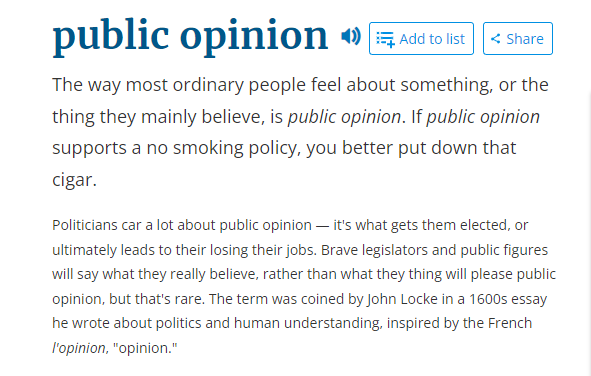Representative Surveys
POLSCI 4SS3
Winter 2024
Announcements
- I asked for classroom change but haven’t heard any news yet
(as of January 24)
Last week
Overview of course topic, goals, evaluation, expectations
We installed R and RStudio and explored them a bit
Cloud option always available if all else fails
Brief overview of MIDA framework
More details in the course website
Today
Start the topic of public opinion
Representative surveys as the standard design
Takeaway: Complete random sampling is the gold standard but too hard to apply in realistic settings
Discussion: Getting surveys right
Lab: Sampling and descriptive inference
Review
What are the elements of a research design?
What is a model?
What is an inquiry?
What is a data strategy?
What is an answer strategy?
Why are we doing this?
Public opinion

Public opinion
The study of self-reported attitudes and behaviors
Primarily among general public
Goal: Mapping self-reports to actual attitudes and behaviors
Two challenges
Asking the right questions
Asking the right people
Asking the right questions

Schwarz (1999)
Elements to consider
- Literal vs. pragmatic meaning
- Open vs. closed answer format
- Frequency scales
(e.g. more that 1 hour) - Reference periods
(last week, last year) - Rating scales
(0-10, -5-5) - Demand effects
- Priming effects
Asking the right people

What is this?

Stephenson et al (2021, p. 120)
Sampling
: How units are selected for a study
Which units?
How will you reach them?
Sampling choices are consequential to how we craft answer strategies
Some key sampling decisions
Mode
(in-person, lab, phone, mail, internet)Sampling frame
Sample size
Sampling procedure
Oversampling
Random sampling
Simple: Coin flip
Complete: Exactly \(n\) of \(N\) sampled with same inclusion probability
Stratified: Sort in groups or strata, then sample
Cluster random: Sample whole groups of units
Stratified cluster: Take a guess!
Multi-stage: Sample clusters, then sample units
Summary
We conduct surveys because we want to understand public opinion
Challenge: Map self-reports to attitudes and behaviors
Ask the right questions
(meaning, format, scales, context)Ask the right people
(mode, sampling)
Why so many choices?
Next Week
Sensitive Questions
Focus on: What to do when people lie in surveys?
Break time!
